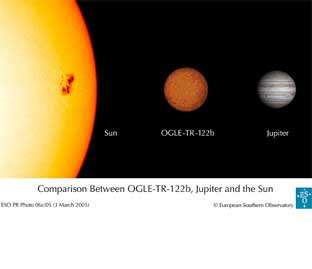Undercover Stars Among Exoplanet Candidates

An international team of astronomers have accurately determined the radius and mass of the smallest core-burning star known until now. The observations were performed in March 2004 with the FLAMES multi-fibre spectrograph on the 8.2-m VLT Kueyen telescope at the ESO Paranal Observatory (Chile). They are part of a large programme aimed at measuring accurate radial velocities for sixty stars for which a temporary brightness "dip" has been detected during the OGLE survey.
The astronomers find that the dip seen in the light curve of the star known as OGLE-TR-122 is caused by a very small stellar companion, eclipsing this solar-like star once every 7.3 days.
This companion is 96 times heavier than planet Jupiter but only 16% larger. It is the first time that direct observations demonstrate that stars less massive than 1/10th of the solar mass are of nearly the same size as giant planets. This fact will obviously have to be taken into account during the current search for transiting exoplanets.
In addition, the observations with the Very Large Telescope have led to the discovery of seven new eclipsing binaries, that harbour stars with masses below one-third the mass of the Sun, a real bonanza for the astronomers.
Source: European Southern Observatory

















